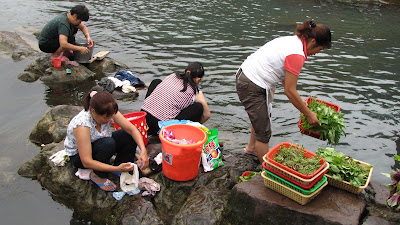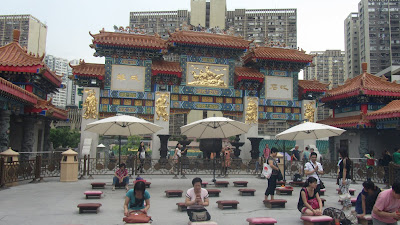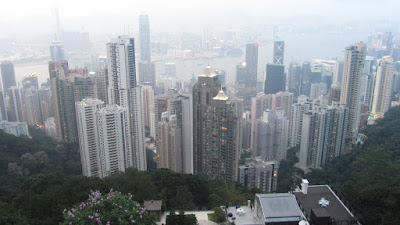



I thoroughly enjoyed my time in South East Asia. It is a fascinating area of the world and there are lots of interesting contrasts to the west. This is a hodge podge of facts I learned. Most apply to Vietnam, as the guide we had there was excellent, and the rest comes from what I learned from Richard.
Thailand is by far the most developed of the four countries. It has embraced the west and accepted the influx of tourists who bring with them western ideals and values. Laos is apparently the poorest, but I thought from my limited time there, that Cambodia looked the poorest. In all four countries there is a huge disparity in wealth and lifestyle. There are some very wealthy people, and a growing middle class, but there are large numbers of people who are very poor and living in incredibly basic accommodation. These people are primarily rural, and are farmers and fishermen who live off the land and what they can grow or catch.
Currency: Thailand, bhat, about 30 to a dollar; Laos, kip, about 8000 to the dollar; Vietnam, dong, 22 to the dollar; and Cambodia, the American dollar and their own currency the riel for small change, about 4000 to the dollar. Makes buying things really interesting.
In Vietnam, Cambodia and Laos the people pay no income tax. This is partly because it is impossible to figure out how much anyone makes, large numbers of people have no money and most transactions are done in cash or barter and there are no records. Not sure how the countries have money, but Richard suggested that some of it comes from foreign aid, which usually lines the pockets of the corrupt officials. When he worked for an Australian company in Cambodia he had to make several visits to the government to get them to tax his earnings as the Australian government required the records. He said he had to pay them to tax him.
Land is very expensive in Ha Noi and Ho Chi Minh City, up to $35000US per sq m. Therefore they build tall skinny buildings with a small base. The cities are very congested and the government in an effort to alleviate this, have taken to building 'suburban' towns trying to draw people out. But, there is no infrastructure – schools, hospitals, and water supplies are not clean. Therefore people prefer to say in the cities, living in crowded areas and don't move. As we drove past some of these towns, although new have never been lived in and now look like deserted, vandalized ghost towns.
The reason that the chaotic traffic I have talked about several times, works, it that it never goes very fast. They approach intersections cautiously. However, if they are about to turn left across lanes of traffic, they will frequently drift across the traffic when they can and drive up the shoulder against traffic until they get to their turn. Thailand drives on the left, the other three on the right.
In order to ease congestion on the streets, cars are highly taxed, 160% more scooters. As a result there are far more scooters on the road than cars.
There are very few accidents, because no one wants to hit anyone else. If there is, the biggest vehicle is at fault where it is or not. They settle the issue right on the spot. If the police arrive you have to pay them, if it goes to the police office, you have to pay everyone there too! So, it is cheaper to resolve on the spot. If someone is killed, the family is called to come and get the body, and they resolve the compensation amongst themselves. Richard said that in Cambodia, occasionally the family will show up armed and kill the driver. He said he once had a phone call from stranded tourists who were on a mini bus that had hit and killed someone and the driver of the mini van had run away from the accident fearing retribution.
Not long ago the people in all these countries used bicycles as their main mode of transportation. Now most of them have been replaced by scooters and small motorcycles. They are the new status symbol and if you ride a bicycle you are thought of as poor. Only recently in Thailand people who are more westernized have seen bicycles as a form of exercise and they are being to use them more. There are very few organized sports here. They love to watch soccer but no one plays. They spend most of the day in the paddies and don't need the exercise, or have the free leisure time. For leisure they prefer to relax, drink, socialize and watch television.
In Vietnam the fishermen have developed a small boat that they can paddle with their feet which leaves their hands free for fishing or bringing in nets.
The Vietnamese in particular will eat dog meat. Several times Richard has seen a Vietnam truck crossing the border back into Vietnam with dozens of dogs in small cages after a raid into Laos to catch feral dogs.
Men wear, at the very least, their pinkie fingernail long to show that they are not poor and don't perform manual labour. They think a mole with hair growing out of it is attractive, so they don't cut them.
There is a huge market for stolen scooters in Vietnam and they are shipped to Cambodia or Laos. As a result everyone parks them indoors. I walked past store fronts that were full of bikes. They are everywhere. Bicycles are stolen too, but less so in recent years. Kids ride bicycles until they can get a scooter. A Honda or Yamaha scooter can cost between $2000 and $4000 dollars, but China makes one they sell for $400! So, they are everywhere.
As I have commented on numerous times it is amazing what they can carry on the scooters, from the number of people (the record I saw was six) to the loads they can carry. Sometimes it's the passenger who carries the load, other times it is strapped on or balanced with one hand while driving with the other. And yes they all have cellphones and use them when riding. I even found a book in a bookstore called 'Bikes of Burden' that was a coffee table book with pictures of what the people carry on the scooters (the best picture was of a very large stingray!).
This area of the world is changing rapidly. Richard has witnessed a definite raising of expectations during the ten years he has lived here, as the people see more and more tourists, more western television and have access to more technology, such as scooter and cellphones. What is incredibly frustrating it the fact that in the west we know, are learning that our expectations are way too high, but \as our economies slow a bit, we export our goods to the poorer countries which raises their expectation and will undoubtedly put a lot more strain on diminishing resources worldwide. There are going to be heavy consequences for this in the not too distant future.
Although we all know that the US had a war against Vietnam, but is less known is that Cambodia and Laos were bombed more than Vietnam. Laos in particular had more bombs dropped on it than all the bombs dropped in Europe during the Second World War! Why? Because the American bombers returning to bases in Thailand, from missions over Vietnam, were not allowed to land with bombs. As a result they jettisoned extra bombs and fuel onto the people of Laos. Cambodia was also bombed extensively because the Viet Cong used the Ho Chi Minh Trail as a supply route from North Vietnam to the Viet Cong resistance fighters in the Mekong Delta and Cu Chi tunnels. There is a huge swath of land in Cambodia that is still full of American laid landmines that still kill and maim people. Some of them are designed as toys to attract children. There are thousands of acres of land in Vietnam that still cannot be used as they are contaminated by Agent Orange.
The whole area has an obvious lack of birds. Halong Bay in particular should have been full of sea birds. Either the area is over fished or they eat them. Richard said that the local people have traditionally eaten birds. In every other country I was awoken by birds at dawn, but not here.
Vietnam practises 'ancestor worship'. When a male member of the family dies, he is buried in a wooden coffin, usually in a rice paddy, three metres deep for three years. The three is important as it represents the three stages of life: past, present and future. After three years the grave is dug up by all the male members of the family. They clean the bones until they are white and then rebury them in a smaller casket on their property. This is done to make sure the spirit can find a clean body to start the next life. Our guide told us that he had helped with his grandfather's bones and found it really dirty and said that he would never forget the smell. Women are not allowed to do this, so obviously families have to have sons. The country used to have a two children family planning policy, but it has been scrapped as some families did succeed in having males and they'd have to hire bone cleaners, who didn't clean the bones as thoroughly as family members would. The males also carry on the family name and take care of their parents when they need it.

















































